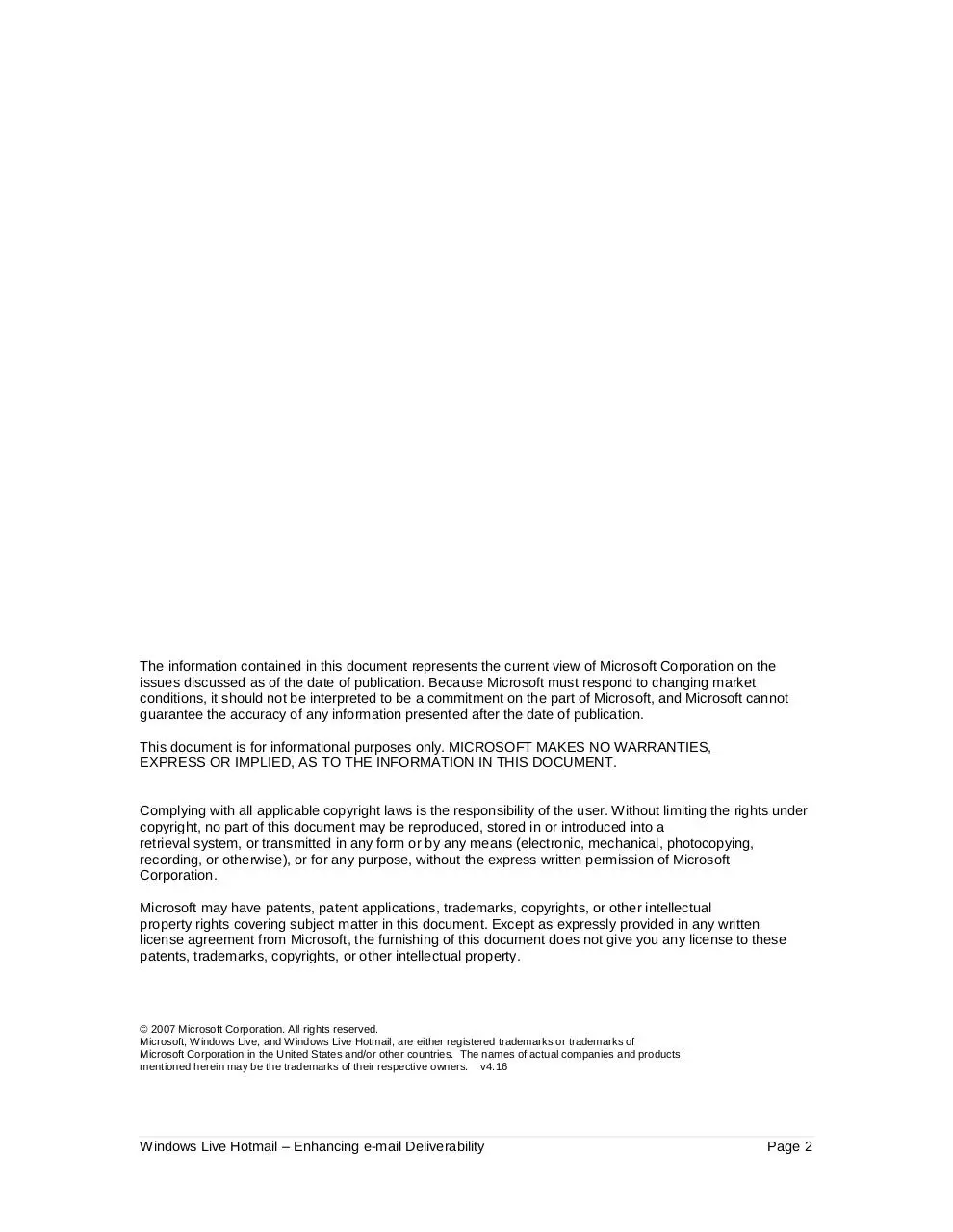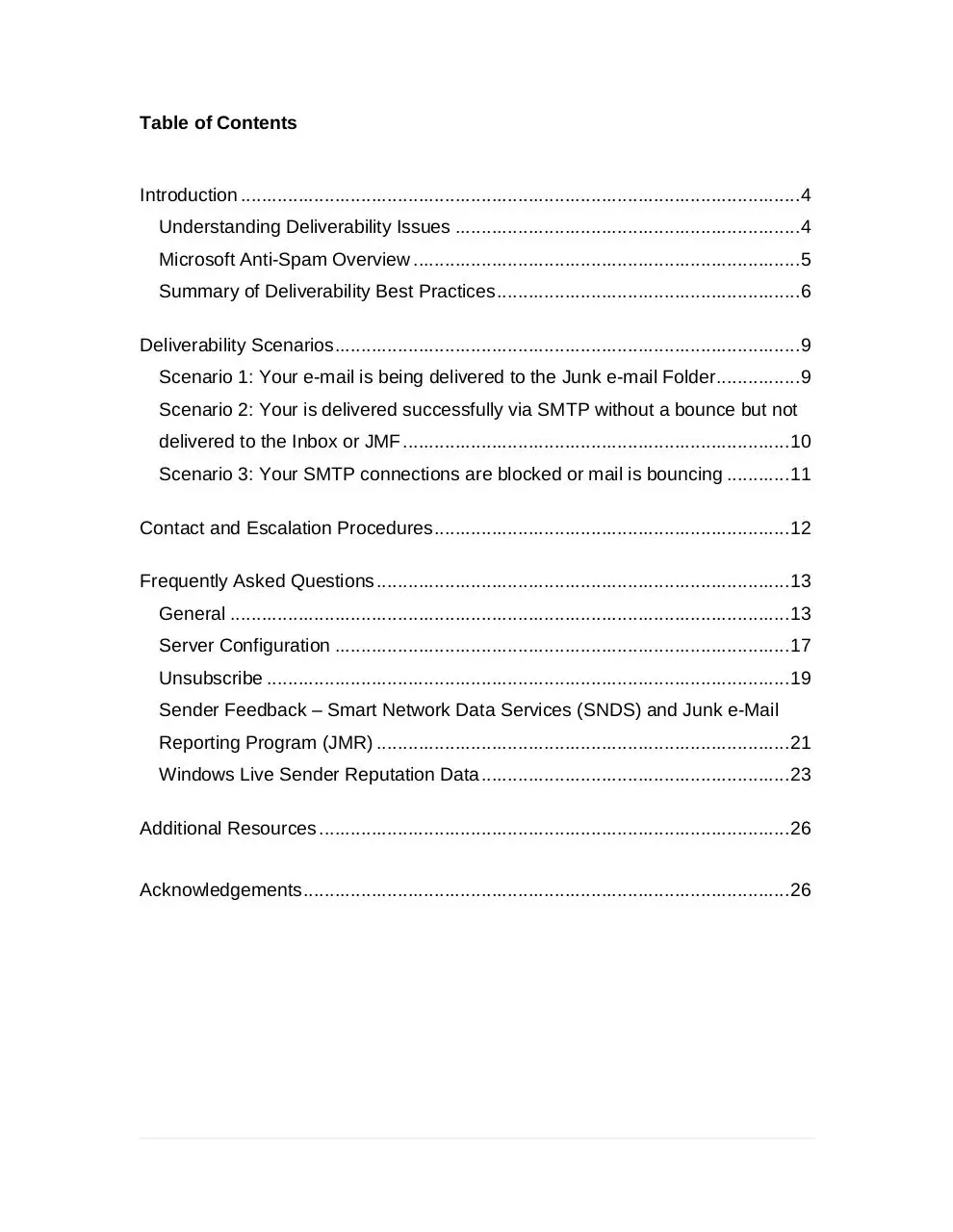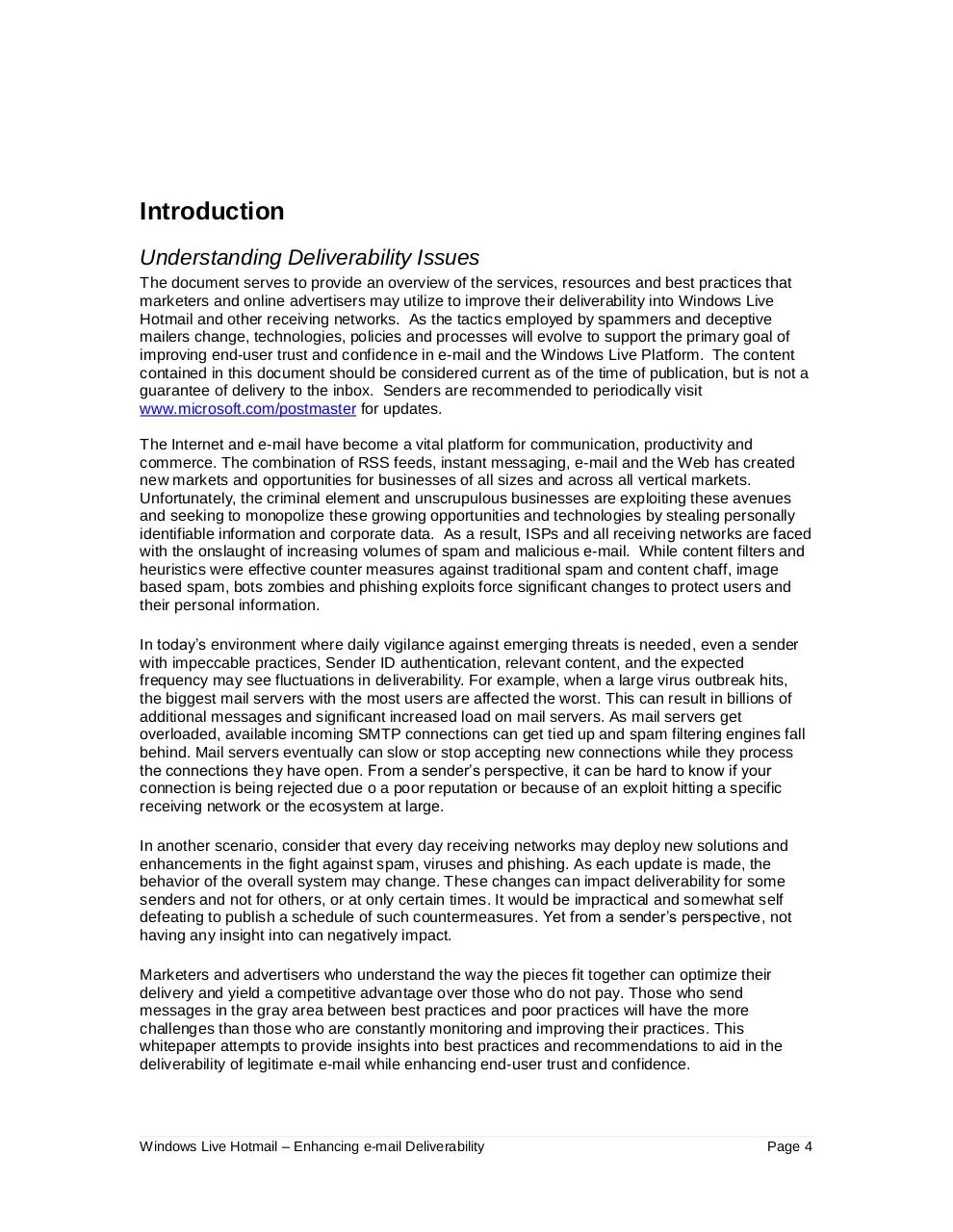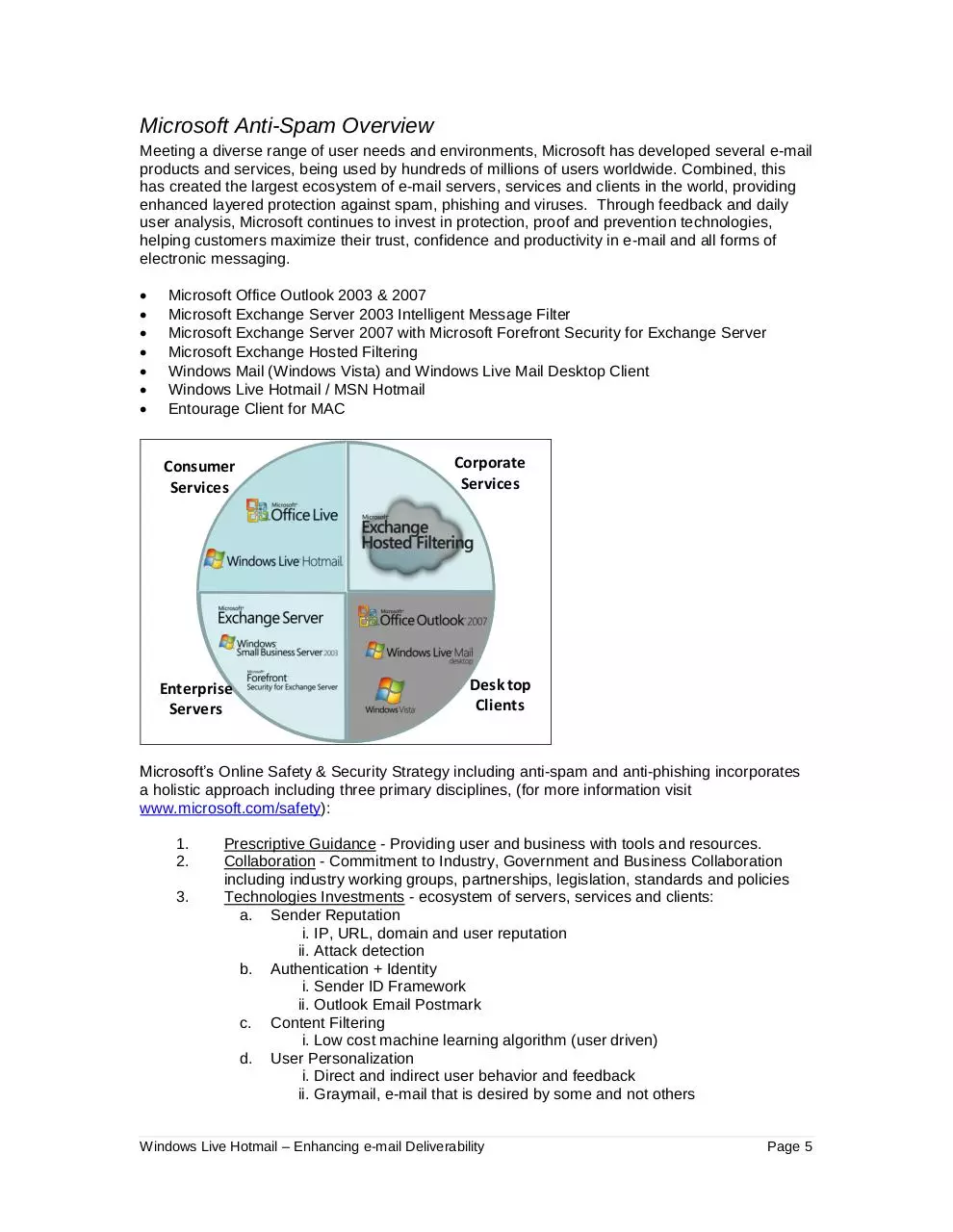enhance deliver (PDF)
File information
This PDF 1.5 document has been generated by Microsoft® Office Word 2007, and has been sent on pdf-archive.com on 04/09/2014 at 17:12, from IP address 208.74.x.x.
The current document download page has been viewed 937 times.
File size: 999.6 KB (26 pages).
Privacy: public file





File preview
Improving E-mail Deliverability into
Windows Live Hotmail
The information contained in this document represents the current view of Microsoft Corporation on the
issues discussed as of the date of publication. Because Microsoft must respond to changing market
conditions, it should not be interpreted to be a commitment on the part of Microsoft, and Microsoft cannot
guarantee the accuracy of any information presented after the date of publication.
This document is for informational purposes only. MICROSOFT MAKES NO WARRANTIES,
EXPRESS OR IMPLIED, AS TO THE INFORMATION IN THIS DOCUMENT.
Complying with all applicable copyright laws is the responsibility of the user. Without limiting the rights under
copyright, no part of this document may be reproduced, stored in or introduced into a
retrieval system, or transmitted in any form or by any means (electronic, mechanical, photocopying,
recording, or otherwise), or for any purpose, without the express written permission of Microsoft
Corporation.
Microsoft may have patents, patent applications, trademarks, copyrights, or other intellectual
property rights covering subject matter in this document. Except as expressly provided in any written
license agreement from Microsoft, the furnishing of this document does not give you any license to these
patents, trademarks, copyrights, or other intellectual property.
© 2007 Microsoft Corporation. All rights reserved.
Microsoft, Windows Live, and Windows Live Hotmail, are either registered trademarks or trademarks of
Microsoft Corporation in the United States and/or other countries. The names of actual companies and products
mentioned herein may be the trademarks of their respective owners. v4.16
Windows Live Hotmail – Enhancing e-mail Deliverability
Page 2
Table of Contents
Introduction ........................................................................................................... 4
Understanding Deliverability Issues .................................................................. 4
Microsoft Anti-Spam Overview .......................................................................... 5
Summary of Deliverability Best Practices .......................................................... 6
Deliverability Scenarios ......................................................................................... 9
Scenario 1: Your e-mail is being delivered to the Junk e-mail Folder ................ 9
Scenario 2: Your is delivered successfully via SMTP without a bounce but not
delivered to the Inbox or JMF .......................................................................... 10
Scenario 3: Your SMTP connections are blocked or mail is bouncing ............ 11
Contact and Escalation Procedures .................................................................... 12
Frequently Asked Questions ............................................................................... 13
General ........................................................................................................... 13
Server Configuration ....................................................................................... 17
Unsubscribe .................................................................................................... 19
Sender Feedback – Smart Network Data Services (SNDS) and Junk e-Mail
Reporting Program (JMR) ............................................................................... 21
Windows Live Sender Reputation Data ........................................................... 23
Additional Resources .......................................................................................... 26
Acknowledgements ............................................................................................. 26
Introduction
Understanding Deliverability Issues
The document serves to provide an overview of the services, resources and best practices that
marketers and online advertisers may utilize to improve their deliverability into Windows Live
Hotmail and other receiving networks. As the tactics employed by spammers and deceptive
mailers change, technologies, policies and processes will evolve to support the primary goal of
improving end-user trust and confidence in e-mail and the Windows Live Platform. The content
contained in this document should be considered current as of the time of publication, but is not a
guarantee of delivery to the inbox. Senders are recommended to periodically visit
www.microsoft.com/postmaster for updates.
The Internet and e-mail have become a vital platform for communication, productivity and
commerce. The combination of RSS feeds, instant messaging, e-mail and the Web has created
new markets and opportunities for businesses of all sizes and across all vertical markets.
Unfortunately, the criminal element and unscrupulous businesses are exploiting these avenues
and seeking to monopolize these growing opportunities and technologies by stealing personally
identifiable information and corporate data. As a result, ISPs and all receiving networks are faced
with the onslaught of increasing volumes of spam and malicious e-mail. While content filters and
heuristics were effective counter measures against traditional spam and content chaff, image
based spam, bots zombies and phishing exploits force significant changes to protect users and
their personal information.
In today‟s environment where daily vigilance against emerging threats is needed, even a sender
with impeccable practices, Sender ID authentication, relevant content, and the expected
frequency may see fluctuations in deliverability. For example, when a large virus outbreak hits,
the biggest mail servers with the most users are affected the worst. This can result in billions of
additional messages and significant increased load on mail servers. As mail servers get
overloaded, available incoming SMTP connections can get tied up and spam filtering engines fall
behind. Mail servers eventually can slow or stop accepting new connections while they process
the connections they have open. From a sender‟s perspective, it can be hard to know if your
connection is being rejected due o a poor reputation or because of an exploit hitting a specific
receiving network or the ecosystem at large.
In another scenario, consider that every day receiving networks may deploy new solutions and
enhancements in the fight against spam, viruses and phishing. As each update is made, the
behavior of the overall system may change. These changes can impact deliverability for some
senders and not for others, or at only certain times. It would be impractical and somewhat self
defeating to publish a schedule of such countermeasures. Yet from a sender‟s perspective, not
having any insight into can negatively impact.
Marketers and advertisers who understand the way the pieces fit together can optimize their
delivery and yield a competitive advantage over those who do not pay. Those who send
messages in the gray area between best practices and poor practices will have the more
challenges than those who are constantly monitoring and improving their practices. This
whitepaper attempts to provide insights into best practices and recommendations to aid in the
deliverability of legitimate e-mail while enhancing end-user trust and confidence.
Windows Live Hotmail – Enhancing e-mail Deliverability
Page 4
Microsoft Anti-Spam Overview
Meeting a diverse range of user needs and environments, Microsoft has developed several e-mail
products and services, being used by hundreds of millions of users worldwide. Combined, this
has created the largest ecosystem of e-mail servers, services and clients in the world, providing
enhanced layered protection against spam, phishing and viruses. Through feedback and daily
user analysis, Microsoft continues to invest in protection, proof and prevention technologies,
helping customers maximize their trust, confidence and productivity in e-mail and all forms of
electronic messaging.
Microsoft Office Outlook 2003 & 2007
Microsoft Exchange Server 2003 Intelligent Message Filter
Microsoft Exchange Server 2007 with Microsoft Forefront Security for Exchange Server
Microsoft Exchange Hosted Filtering
Windows Mail (Windows Vista) and Windows Live Mail Desktop Client
Windows Live Hotmail / MSN Hotmail
Entourage Client for MAC
Consumer
Services
Corporate
Services
Product Logos go here!
Enterprise
Servers
Desk top
Clients
Microsoft‟s Online Safety & Security Strategy including anti-spam and anti-phishing incorporates
a holistic approach including three primary disciplines, (for more information visit
www.microsoft.com/safety):
1.
2.
3.
Prescriptive Guidance - Providing user and business with tools and resources.
Collaboration - Commitment to Industry, Government and Business Collaboration
including industry working groups, partnerships, legislation, standards and policies
Technologies Investments - ecosystem of servers, services and clients:
a. Sender Reputation
i. IP, URL, domain and user reputation
ii. Attack detection
b. Authentication + Identity
i. Sender ID Framework
ii. Outlook Email Postmark
c. Content Filtering
i. Low cost machine learning algorithm (user driven)
d. User Personalization
i. Direct and indirect user behavior and feedback
ii. Graymail, e-mail that is desired by some and not others
Windows Live Hotmail – Enhancing e-mail Deliverability
Page 5
As part of Microsoft‟s commitment to online safety and protecting the e-mail ecosystem, Windows
Live Hotmail has made the following investments with the mutual goals of protecting users from
deceptive and unwanted e-mail, reducing Spam in the Inbox (SITI), reducing operational impact
while improving the deliverability of legitimate e-mail. Receiving feedback from millions of endusers Microsoft has developed the new Windows Live Platform including;
New Safety UI to help warn and protect users from spoofed or phishing e-mails
IP Throttling and block lists to reduce overall volume
Integration of the Sender ID Framework, authenticating inbound and outbound e-mail
Junk e-Mail Reporting Program (JMR)
Smart Network Data Services (SNDS)
We continue to improve deliverability for legitimate senders by improving IP and volume based
reputation data. At Hotmail, the Sender ID verdict result is combined with pre-existing reputation
data to determine an enhanced e-mail “trustworthy score”. Computation proofs, such as the
Outlook 2007 Postmark, help end-user systems distinguish between legitimate mail and spam,
reducing the incidence of false positives and enhancing their individual mail deliverability.
Offering a safe and secure unsubscribe option has helped reduce the number of user complaints,
providing senders enhanced data for list management , while not adversely impacting their overall
1
reputation .
Looking ahead, Microsoft will continue to research and invest in reputation and authentication
technologies. Conceptually servers, services and clients will share central reputation data.
Multiple levels of reputation will be tracked including IP, URL, domain and use. The Sender ID
Framework and the Outlook Postmark will help authenticate users and create identities. Finally,
user personalization elements will be integrated as we continue to learn from user to better
distinguish good e-mail from bad e-mail.
Summary of Deliverability Best Practices
Specific to Windows Live Hotmail, we highly recommending following these steps to ensure the
highest deliverability rates:
Step 1 - Ensure Compliance -With Windows Live Policies and Technical Requirements
• http://postmaster.live.com/Guidelines.aspx
Step 2 - Follow best practices and FAQ’s
• http://postmaster.live.com/Troubleshooting.aspx
• http://www.microsoft.com/postmaster
Step 3 - Adopt Sender ID and Keep Your Record Current
• http://www.microsoft.com/safety
• http://www.microsoft.com/SenderID
Step 4 – Join the Junk e-Mail Reporting Program
• http://support.msn.com/default.aspx?productkey=edfsJMRp&mkt=en-us
Step 5 – Leverage Smart Network Data Services (SNDS)
• https://postmaster.live.com/snds/index.aspx
Step 6 – Contact Deliverability Support - If you‟re still having issues:
http://support.msn.com/eform.aspx?productKey=edfsmsbl&page=support_home_options_form_b
yemail&ct=eformts
1
In the future Senders who realize an excessive number of unsubscribe requests may have their reputation
impacted.
Windows Live Hotmail – Enhancing e-mail Deliverability
Page 6
Consistent and reliable e-mail deliverability generally comes down being consistent, monitoring
your reputation proactively and following best practices. The following tenets and their impact to
deliverability should be considered by all senders and online marketers:
1. Complaints - This occurs automatically when a user clicks “block and delete”, “report spam”
or similar reporting options including escalations and user complaints. This might be the
complaint rate or just the total number of complaints depending on the receiver.
2. High unknown user rates - How clean is your list? Are you sending mail to users that have
moved on and changed address? Do you have a lot of dead addresses on your list? This is
an indicator by many receivers that you may be a spammer and indicator of harvested
address lists.
3. Spam trap addresses - These are addresses (in some cases a domain) that have never
been signed up to receive any kind of message or have been deactivated after prolonged
inactivity by the ISP. Typically ISPs and law enforcement agencies create these and post
them on web sites to be “harvested”.
4. Sending infrastructure - Spammers steal resources and have difficulty setting up “industrial
strength” infrastructure. Many receivers look for well set up infrastructure as another
indicator.
5. Sending “permanence” (Consistency) – Sending from the same IP address with consistent
volumes and frequencies month over month is ideal. Spammers tend to “pop up” on an IP
and disappear. Infrequent senders who send large volumes once a month or quarterly can
be an indicator of a spammer or a compromised server.
6. Content – Senders be focused on e-mail content, as well as the URLs and HTML elements
embedded in their e-mail. Anti-spam systems and heuristics continue to incorporate content
filtering with authentication and reputation for a combined “trustworthy” score. Reputation
scoring can compensate for content which may appear “spammy”, resulting in improved
deliverability and a reduction in false positives.
The following sender best practices may help increase your chances for successful deliverability:
Complaints
• Add “list unsubscribe” header to e-mails offering subscribers a clean way to opt out
• Honor unsubscribes requests. Opting out should be just as simple as opting in
• Add text reminding subscribers where they opted-in to receive your e-mail
• Monitor your complaint rates. Most major services or e-mail service providers offer monitoring
tools for free or as part of their service.
• Validate you are adhering to applicable anti-spam and privacy laws and policies
• Ensure your marketing communications are timely, relevant, have been requested and that
you have permission to send them to the user.
• Consider the frequency of your mailings. What are the user‟s expectations?
High unknown user rates
• Maintain your mailing lists. This includes purging old, bad or inactive addresses from your
mailing lists. Also, this means acquiring names responsibly and sending mail only to users
that “opt-in” to receiving your e-mail.
Windows Live Hotmail – Enhancing e-mail Deliverability
Page 7
Spam trap addresses
• Monitor and manage both hard and soft bounces. Bounce notices can provide invaluable
information regarding the ISP‟s treatment of your e-mail.
Sending infrastructure
• Choose content wisely and verify URLs look normal and point to valid domains
• Format a reply header to ensure subscribers see your “friendly” e-mail address
• Use a reputable e-mail service provider who has relationships with ISPs, such as AOL,
Yahoo and Windows Live Hotmail
• Implement outbound e-mail authentication using the Sender ID Framework, with a valid “-all”
record. This helps protect from spoofing and ensure your MTA is authorized to send mail,
while protecting the brand and domain from threats to their brand and misrepresentation.
• Segment or separate traffic by brand or type of mail. Corporate e-mail, customer acquisition,
customer retention and transactional e-mails should be segmented. Senders who wish to
maintain separate reputations for each should consider segment mail streams by IP address
and publishing separate SPF records.
• Set up, monitor and proactively manage your user feedback data. Feedback loops contain
valuable spam complaint information
Sending “permanence”
• Be consistent – Send e-mail from the same IP‟s
• Less is more. Send less mail more often vs. lots of mail for short periods of time
The bottom line to remember is: if as little as 1% of your customers complain, the inability to
communicate with your entire customer base may be the end result.
Finally, before launching any campaign, thorough testing is recommended. This means frequent
testing with recipient accounts using various clients and major e-mail service providers to ensure
that communications are being received in a desired fashion.
Windows Live Hotmail – Enhancing e-mail Deliverability
Page 8
Deliverability Scenarios
Scenario 1: Your e-mail is being delivered to the Junk e-mail Folder
Symptoms
1. Open, click and unsubscribe rates decline
2. Recipients inform you that your e-mail is delivered to the JMF
3. Some or all of the e-mail sent to your personal Windows Live Hotmail account is delivered to
the Junk e-mail Folder (JMF).
Common Causes
Too many recipients
reported your previous emails as spam
Recommended Actions
Too much of your mail is
sent to invalid or inactive
e-mail addresses
Your Sender ID record is
incorrect or missing
Change the Subject lines of your messages to be more
relevant
Make sure the From address is recognizable and would never
be perceived as deceptive
Reduce the frequency of your messages
Make sure you are sending what the recipients expect to
receive
Increase the relevance of your messages
Reduce frequency to addresses that have not opened or
clicked recently
Make the Unsubscribe option easy to find and use
Include a List-Unsubscribe header
Send an immediate confirmation message
Add more relevant text content to your messages
Sign up for the Smart Network Data Services (SNDS) service
from http://postmaster.live.com for a daily view of your
complaint rates.
Sign up for the Junk e-Mail Reporting Program (JMR) to
receive junk e-mail complaints reported by customers for your
IP addresses. For more details, see http://postmaster.live.com.
Avoid mailing addresses that have not responded to your mail
(i.e. opened or clicked) recently, or from users that have
requested to be unsubscribed
Ensure that addresses that receive NDRs or bounce more
than 2X are removed
Sign up for the Smart Network Data Services (SNDS) service
from http://postmaster.live.com for a daily view of delivery
attempts to our Dynamic Trap Accounts - DTA‟s.
Insure your outbound mail is Sender ID compliant by publishing
an SPF record in your DNS and that your IP‟s and related
domain records are current
Windows Live Hotmail – Enhancing e-mail Deliverability
Page 9
Download enhance deliver
enhance_deliver.pdf (PDF, 999.6 KB)
Download PDF
Share this file on social networks
Link to this page
Permanent link
Use the permanent link to the download page to share your document on Facebook, Twitter, LinkedIn, or directly with a contact by e-Mail, Messenger, Whatsapp, Line..
Short link
Use the short link to share your document on Twitter or by text message (SMS)
HTML Code
Copy the following HTML code to share your document on a Website or Blog
QR Code to this page

This file has been shared publicly by a user of PDF Archive.
Document ID: 0000182413.